- Author Curtis Blomfield [email protected].
- Public 2023-12-16 20:44.
- Last modified 2025-01-23 17:01.
Pathologies of the cardiovascular system are one of the most common causes of death in the population. This group of diseases is especially common among the elderly. Diagnosis of cardiac pathologies at an early stage helps to reduce the risk of complications and mortality. One of the research methods is echocardiography. This diagnostic method is necessary to assess the activity of the heart. Often, echocardiography is performed using an ultrasound probe, which is placed on the chest wall. In some cases, this study is performed during surgery. Then transesophageal echocardiography is performed. This method allows you to visualize the heart in more detail.
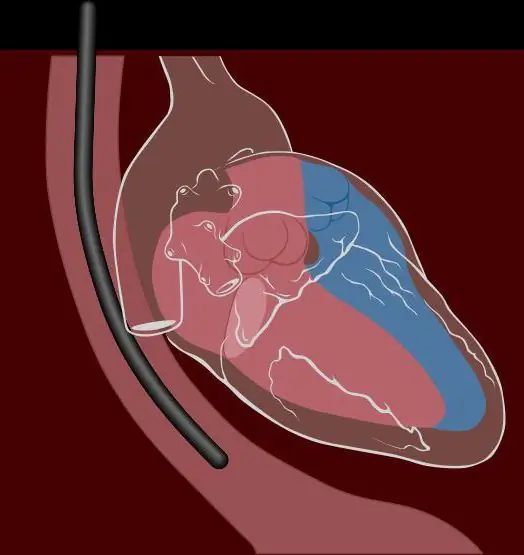
Transesophageal echocardiography - what is it?
Echocardiography is one of the main ways to diagnose diseases of the cardiovascular system. It can be performed at any age, as it is not accompanied by radiation exposure to the body. Thanks to this toolThe study can visualize the size and thickness of the chambers of the heart, assess the condition of the valves. Transesophageal echocardiography (TEE) is different in that it is carried out as if from the inside, and not from the outside (chest wall). This improves the quality of the visualization. This examination is not prescribed for everyone, but only for special indications. To perform echocardiography through the esophageal cavity, it must first be performed transthoracically. This method of diagnosis is carried out by a specially trained specialist in a hospital.
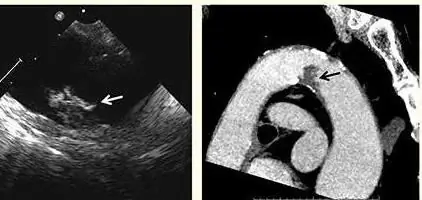
What is transesophageal echocardiography based on?
Transesophageal echocardiography of the heart is an imaging modality based on ultrasound. Ultrasound is performed using a special probe and gel. The device creates high-frequency sound waves. Tissues "respond" to these signals by the type of echolocation. Given that each organ has a certain density and structure, they are displayed differently on the monitor screen connected to the device. The study is carried out in real time. This means that the doctor of functional diagnostics can assess the state of the chambers of the heart, while the sensor slides over the surface of the organ. Unlike transthoracic echocardiography, transesophageal examination allows you to see even minimal structural abnormalities. The fact is that when conducting ultrasound on the chest wall, it is not always possible to achieve sufficient visualization of the heart. This is due to the fact that the device "captures"echo signals from other organs: ribs, adipose tissue, muscle tissue. When performing TEE, the “ultrasound window” is significantly reduced, making this method more informative.
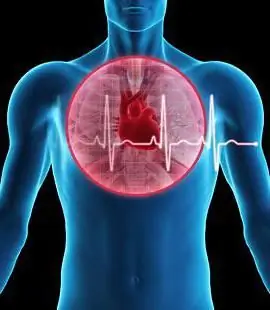
Indications for testing
The main indication for the study is the inability to make a diagnosis based on the data of transthoracic echocardiography. Typically, this diagnostic procedure is performed on patients who are suspected of serious cardiac disorders. It is also necessary in the study of the cavity of the body. Given that ultrasound examination through the surface of the chest wall in these cases is not informative, transesophageal echocardiography is performed. Test indications:
- Complications after prosthetic heart valves. In some cases, the implant takes a long time to take root, resulting in inflammation, abscesses.
- Dissection of an aneurysm of the heart or aorta.
- Poor functioning of prosthetic valves.
- Infectious lesions of the heart muscle - endo-, myo-, pericarditis.
- Aortic abscess.
- Thrombosis of the ventricle of the heart.
- The need for research at the time of surgery.
In addition to these indications, transesophageal echocardiography is a mandatory procedure before valve replacement. Also, the study is performed with increased airiness of the lungs (emphysema), obesity.
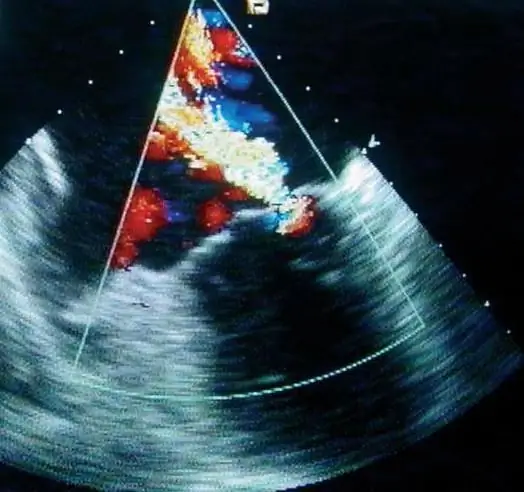
Contraindications for transesophageal echocardiography
Despite the advantages of TEE, this method of examination is not widely used. This is because it is invasive and not all patients agree to the procedure. In addition, there are a number of contraindications for transesophageal echocardiography. Among them:
- Inflammatory diseases of the oral cavity and pharynx.
- Anomalies in the development of organs (short esophagus, diverticulum).
- Cicatricial changes, strictures. Often found after poisoning with acids or alkalis.
- Erosive esophagitis.
- Bleeding from an ulcer in the cardia of the stomach.
- Dilation of the veins of the esophagus in liver cirrhosis.
- Oncological diseases of the oral cavity and pharynx.
- Cancer of the esophagus or cardia of the stomach.
In the absence of gastrointestinal disease, TEE can be performed on patients of any age. Also, the study is not contraindicated for pregnant women and people suffering from somatic pathologies. It is not accompanied by irradiation of the body.
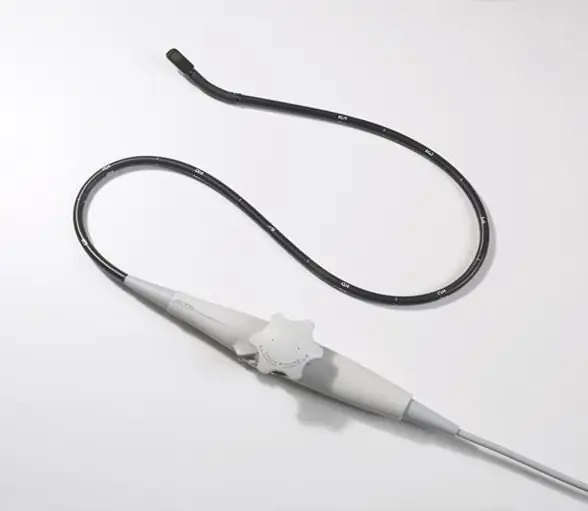
Preparation for transesophageal echocardiography
Before ordering a transesophageal echocardiography, the patient must be sent to undergo a series of laboratory tests. Among them: a biochemical blood test, KLA and OAM, a coagulogram. In this case, changes such as an increase in leukocytes, platelets, and an acceleration of ESR can be observed. In addition, before thisexaminations, transthoracic ultrasound is often performed. In addition, if a heart pathology is suspected, an ECG is necessary.
Transesophageal echocardiography is a safe procedure and does not require special preparation. If the patient is taking any medications, then it is not necessary to cancel them before the study. A prerequisite for the procedure is the refusal to eat within 6 hours prior to TEE. If the patient has dentures, they must be removed. Sometimes, premedication is carried out before the study. To reduce salivation, the drug "Atropine" is administered intravenously. If the patient is in an excited state, tranquilizers are prescribed (medication "Diazepam").
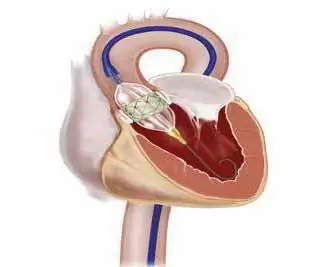
Technique for performing transesophageal echocardiography
To avoid discomfort, the mouth and throat are anesthetized. For this purpose, the drug "Lidocaine" or "Dikain" is used. The patient is placed on the left side. In order not to damage the probe and facilitate its introduction into the pharynx, a special mouthpiece is used. The end of the device must be treated with a special gel that is used in ultrasound examinations. After that, the probe with the endoscope is inserted into the cavity of the esophagus. To facilitate the process, the patient must perform swallowing movements. Within 5-10 minutes the device is in the cavity of the esophagus. The endoscope lamp is directed towards the heart. Through the wall of the esophagus, the device captures echo signals. They are displayed in real timemonitor and recorded on tape.
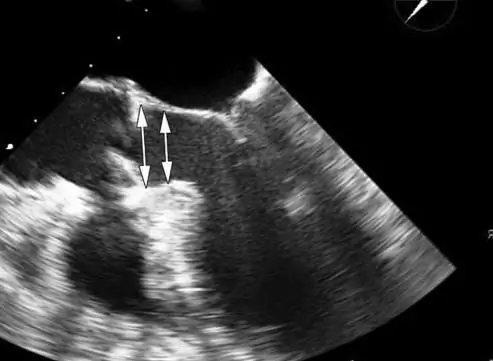
What can be detected by transesophageal echocardiography
Thanks to echocardiography performed through the cavity of the esophagus, it is possible to assess the condition of the heart muscle, endocardium and valvular apparatus. This study is decisive in making a diagnosis. Given the high information content of the method, even minor damage to the heart cavity can be detected. TEE allows to detect the presence of blood clots, inflammatory changes, aortic dissection. A three-dimensional study is particularly informative. Thanks to 3D ultrasound cardiography, it is possible not only to assess the state of the heart muscle, but also to prepare the patient for valve replacement surgery. This method belongs to high-tech research and is carried out in specialized clinics.
Possible complications of transesophageal echocardiography
One of the diagnostic methods is transesophageal echocardiography of the heart. Where is this procedure done? This study is performed in dispensaries with a cardiology department, as well as in private clinics equipped with modern medical equipment. It is worth remembering that, despite the safety, in rare cases, complications may develop. These include heart rhythm disturbances, as well as allergic reactions to drugs (anesthetics, tranquilizers). To avoid serious consequences, it is necessary to have a resuscitation kit ready.
Transesophageal echocardiography of the heart: feedback from patients and doctors
This study is safe and painless, so patients tolerate it well. To diagnose serious pathologies, transesophageal echocardiography is performed. Reviews of doctors about this method of examination are positive. Doctors note its high information content and safety.




